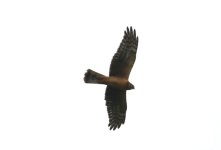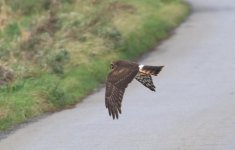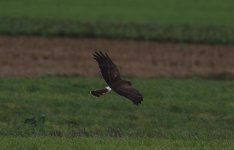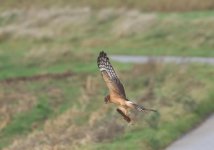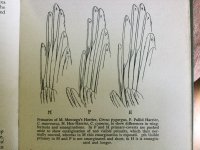Ask Andreas Gullberg. He is THE expert on the subject
A lot of good comments already. Here is my opinion about the Danish bird. Maybe not surprising I think it looks perfect, in all aspects, for a juvenile female NH.
PH x HH hybrids are not uniform in plumage because of various degree of genetic material from the two species and based on sex. So, we can reduce the complexity a bit if we compare the Danish bird with a female (juvenile) hybrid and not mixed it with hybrid males.
I mean a hybrid can be excluded on the following characteristics:
Wing formula
The HH and NH has (more or less) the same wing formula. The Danish bird has a HH wing formula, i.e. broad hand with a HH long P6 and the outer vane shows a clear emargination at the “right” distance from the top. On a hybrid you expect a little bit slimmer hand with a shorter p6 and with an emargination of the outer vane closer to the top.
Boa and collar
The boa on the Danish bird is typical for a juvenile female NH with very dark dense streaking, very well defined, as well as complete around the upper breast. In all it makes the whole head contrast sharply against a light underbody. On a hybrid you expect a paler boa, with more obvious streaking and with more diffuse transition to body and it will not be complete around upper breast.
The collar on the Danish bird is also right for a NH by being less prominent (slimmer and more streaked) than what to expect on a hybrid.
Face colour and pattern
The Danish bird have a very dark head with rather small white/pale spots above and below eye as is typical for NH. A hybrid would expect to have a paler head with larger and more ablong shaped spots (especially below eye).
Body colour
Female juvenile ringtails have in general warmer coloured than the juvenile males. Normally a hybrid would expect to be less orange and warm coloured than a PH. The Danish bird is as least as warm coloured as a PH and with the more rusty or red tone that is so typical for juvenile female NHs.
A comment on the streaking of body. I think the streaking on the Danish bird matches a juvenile female NH perfectly. On the other hand, I think the streaking could be (more or less) identical to a juvenile female hybrid, so I would not use that as a pointer in any direction here.
Comments on underwing pattern and colour
Female juvenile ringtails have in general fewer dark bars on the longest fingers (p9-7) than the juvenile males. A hybrid could also have six dark bars as the Danish birds. In general, a NH would have finer and more regular bars than a hybrid, but I guess it could be identical. So, it should imo be used as a supporting character more than an absolute one.
Female juvenile ringtails have in general darker secondaries than the juvenile males. Since PH has darker secondaries than a HH, you should expect a hybrid to have darker secondaries than HH. The NH has, what I have experience, almost as dark secondaries as a HH. Maybe NH in general has a slimmer dark middle secondary bar that makes the arm a bit paler? The Danish bird has a normal NH/HH dark arm. This is imo also a supporting character.




